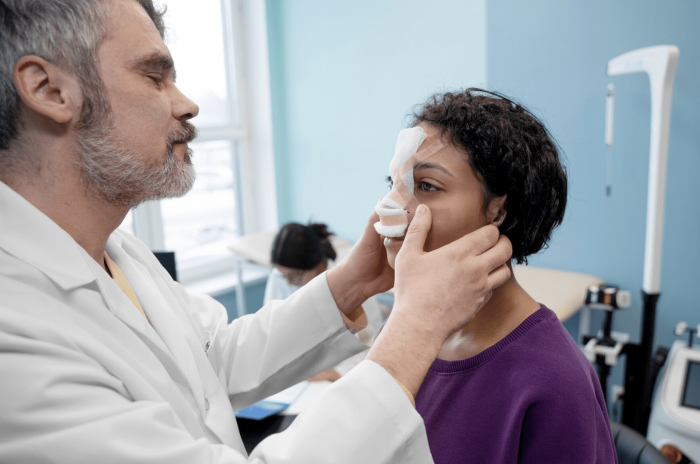Rhinoplasty, commonly referred to as a nose job, is a surgical procedure aimed at altering the shape and size of the nose for aesthetic or functional reasons. This surgery can address a variety of concerns, including correcting deformities resulting from trauma, enhancing facial symmetry, or improving breathing difficulties caused by structural abnormalities.
The procedure can be performed using either an open or closed technique, depending on the complexity of the surgery and the surgeon's preference. Open rhinoplasty involves making incisions on the outside of the nose, providing better access for more extensive alterations, while closed rhinoplasty involves incisions made within the nostrils, leaving no visible scars. Rhinoplasty can significantly enhance a patient's appearance and self-esteem while addressing functional nasal issues, making it a popular choice in cosmetic surgery.
Common Reasons for Undergoing Rhinoplasty
Individuals choose to undergo rhinoplasty for various reasons, primarily focused on aesthetics and functionality. Cosmetic reasons often include dissatisfaction with the nose's size, shape, or profile, such as a prominent hump, a wide or bulbous tip, or asymmetry. Many patients seek rhinoplasty to achieve better facial balance and harmony, enhancing their overall appearance.

Functional concerns also play a significant role in the decision to undergo rhinoplasty. Patients with breathing difficulties due to a deviated septum, enlarged turbinates, or other structural issues may opt for this surgery to improve airflow and nasal function. In some cases, patients may pursue rhinoplasty to repair nasal deformities resulting from injury, ensuring both aesthetic appeal and proper functionality.
Understanding the Importance of Preoperative Assessment
A thorough preoperative assessment is crucial for ensuring the safety and success of rhinoplasty. During this assessment, the surgeon evaluates the patient's medical history, current health status, and specific nasal concerns. This comprehensive evaluation allows the surgeon to identify any underlying health issues that may affect the surgery and recovery process.
Additionally, this assessment involves discussing the patient's expectations, desired outcomes, and any potential risks associated with the procedure. By establishing clear communication and understanding the patient's goals, the surgeon can develop a tailored surgical plan that aligns with the patient's needs, ultimately leading to more satisfying results.
General Risks Associated with Any Surgical Procedure
All surgical procedures carry inherent risks, and rhinoplasty is no exception. General risks associated with surgery include infection, excessive bleeding, adverse reactions to anesthesia, and blood clots. These complications can occur in any surgical setting, underscoring the importance of choosing a qualified and experienced surgeon.
Patients should also be aware that their overall health can impact the risk of complications. Factors such as age, pre-existing medical conditions, and lifestyle choices like smoking can increase the likelihood of adverse outcomes. A thorough preoperative assessment helps to mitigate these risks by ensuring that patients are in optimal health before undergoing surgery.
Specific Risks Related to Rhinoplasty
While rhinoplasty is generally considered safe, it comes with specific risks that patients should understand. These include complications such as persistent swelling, changes in skin sensation, nasal obstruction, and dissatisfaction with aesthetic results. In some cases, patients may require revision surgery if the desired outcome is not achieved or if complications arise.
Other specific risks include the formation of scar tissue, which can affect the nose's appearance and functionality, and the potential for changes in the sense of smell. It's essential for patients to have realistic expectations about the surgery and understand that while complications are rare, they can occur. A qualified surgeon will provide detailed information about these risks during the preoperative consultation, helping patients make informed decisions about their rhinoplasty journey.
Potential Complications During Surgery
Rhinoplasty, like any surgical procedure, carries risks of complications during the operation. These may include excessive bleeding, adverse reactions to anesthesia, or accidental damage to surrounding structures, such as the nasal cavity or sinuses. It’s crucial for the surgeon to be well-prepared to manage these risks to ensure patient safety.

Post-Operative Risks: What to Expect
After rhinoplasty, patients may experience a range of post-operative risks, including swelling, bruising, and pain. These symptoms are typically temporary; however, more serious complications, such as infections or poor wound healing, can occur. Patients should be monitored closely during the recovery period to identify and address any issues promptly.
Infection Risks and How to Mitigate Them
Infection is a potential risk associated with rhinoplasty, primarily due to the surgical incisions. To mitigate this risk, surgeons typically prescribe prophylactic antibiotics before and after the procedure. Patients should also adhere to proper post-operative care instructions, including keeping the surgical site clean and avoiding activities that may introduce bacteria.
Understanding Anesthesia-Related Risks in Rhinoplasty
Anesthesia is an essential aspect of rhinoplasty, but it comes with inherent risks. Patients should be informed about potential complications, such as allergic reactions, respiratory issues, or cardiovascular events. A thorough pre-operative evaluation and discussion with the anesthesia provider can help minimize these risks and ensure patient safety.
Scarring: A Common Concern in Rhinoplasty
Scarring is a common concern for patients undergoing rhinoplasty. While surgeons strive to place incisions in inconspicuous areas, some degree of scarring is inevitable. Over time, most scars will fade significantly, but patients should discuss their concerns with their surgeon and understand the factors that can influence scar appearance, such as skin type and healing ability.
Nasal Obstruction: Causes and Solutions
Nasal obstruction can occur following rhinoplasty due to swelling, scarring, or structural changes. Patients experiencing persistent nasal blockage should consult their surgeon, who may recommend treatments ranging from conservative measures, such as nasal sprays, to revisional surgery if necessary to restore proper airflow.
Revisional Rhinoplasty: When Is It Necessary?
Revisional rhinoplasty may be necessary if patients are dissatisfied with their initial results or experience complications that affect function or aesthetics. Common reasons for revision include asymmetry, unresolved nasal obstruction, or undesirable changes in nasal shape. A thorough evaluation by a qualified surgeon is essential to determine the need for revision.
Managing Bleeding and Hematoma After Surgery
Post-operative bleeding and hematoma formation are potential complications following rhinoplasty. Patients are advised to rest, keep their heads elevated, and avoid strenuous activities to minimize these risks. If significant bleeding occurs or a hematoma develops, prompt medical attention may be required to address the issue effectively.
The Psychological Impact of Surgical Complications
Experiencing complications after rhinoplasty can have psychological effects, including anxiety, depression, or dissatisfaction with the surgical results. Open communication with the healthcare team and access to support resources can help patients cope with these challenges and maintain a positive outlook throughout their recovery journey.
Importance of Choosing a Qualified Surgeon
Choosing a qualified and experienced surgeon is paramount to minimizing risks and achieving satisfactory results in rhinoplasty. Patients should research potential surgeons, review their credentials, and seek referrals to ensure they are in capable hands. A skilled surgeon will provide comprehensive care, addressing any concerns and ensuring the best possible outcomes.
How to Prepare for Rhinoplasty to Minimize Risks
Proper preparation for rhinoplasty is essential to minimize risks and enhance surgical outcomes. Patients should start by discussing their medical history and any medications with their surgeon during the consultation. It's advisable to avoid blood-thinning medications, such as aspirin and non-steroidal anti-inflammatory drugs (NSAIDs), at least two weeks before surgery. Additionally, patients should follow pre-operative instructions, which may include fasting, arranging transportation for post-surgery, and setting up a comfortable recovery space at home.
Recovery Tips to Reduce Complications
After rhinoplasty, following recovery tips can significantly reduce complications. Patients should rest and keep their heads elevated to minimize swelling. It’s also important to avoid strenuous activities and heavy lifting for at least two weeks. Adhering to the prescribed medication regimen for pain management and inflammation is crucial. Regular follow-up appointments with the surgeon will help monitor healing and address any issues early on.
Recognizing Signs of Complications After Surgery
Patients should be vigilant in recognizing signs of complications after rhinoplasty. Symptoms such as excessive bleeding, severe pain, persistent swelling, fever, or unusual discharge from the surgical site may indicate an infection or other complications. Prompt communication with the surgical team is essential if any of these signs arise to ensure timely intervention and prevent further issues.
Long-Term Risks: What Patients Should Know
While rhinoplasty is generally safe, patients should be aware of potential long-term risks. Changes in nasal structure, persistent nasal obstruction, and dissatisfaction with aesthetic results are possible. Additionally, some patients may experience ongoing sensitivity or changes in skin texture around the nose. Understanding these risks enables patients to set realistic expectations and maintain open communication with their surgeon regarding any concerns.
The Impact of Rhinoplasty on Breathing Function
Learn about how rhinoplasty can affect breathing function both positively and negatively. This section discusses how correcting structural issues in the nasal passages can enhance airflow and alleviate breathing difficulties, while also addressing possible complications that might arise post-surgery.
Exploring Non-Surgical Alternatives to Rhinoplasty
Investigate the various non-surgical alternatives to rhinoplasty that offer cosmetic improvements without the need for invasive surgery. Techniques such as dermal fillers and nose reshaping using threads can provide temporary results, appealing to those seeking subtle changes with minimal recovery time.
Best Rhinoplasty Treatment in India
The Best Rhinoplasty Treatment in India is performed by expert surgeons who utilize advanced techniques to ensure optimal outcomes for patients, offering a personalized treatment plan tailored to individual health needs.
Best Rhinoplasty Hospitals in India
The Best Rhinoplasty in India are equipped with cutting-edge technology and facilities, providing top-notch care, including pre-surgery consultations, surgical expertise, and post-operative recovery support to ensure a smooth patient journey.
Rhinoplasty Cost in India
When considering the Rhinoplasty Cost in India, patients benefit from affordable and transparent pricing at leading hospitals, which offer cost-effective treatment options without compromising the quality of care.
Best Rhinoplasty Doctors in India
The Best Rhinoplasty Doctors in India are highly experienced in performing the surgery, utilizing a patient-centric approach that ensures personalized care, precise surgical techniques, and dedicated follow-up care to enhance recovery.
FAQs About Risks and Complications in Rhinoplasty
What are the most common complications associated with rhinoplasty?
Common complications include bleeding, infection, nasal obstruction, and dissatisfaction with aesthetic results.
How can I minimize risks before my rhinoplasty?
Avoid blood-thinning medications, follow your surgeon’s pre-operative instructions, and disclose your full medical history.
What should I do if I notice signs of complications after surgery?
Contact your surgeon immediately if you experience excessive bleeding, severe pain, or signs of infection.
Are there long-term risks associated with rhinoplasty?
Yes, potential long-term risks include structural changes, persistent nasal obstruction, and dissatisfaction with results.
How can I ensure a successful recovery after rhinoplasty?
Rest, keep your head elevated, follow medication guidelines, and attend follow-up appointments to monitor your recovery.
Related Resources
At ArogyaJivan, we strive to provide you with the most accurate and up-to-date information to help you make informed decisions about your healthcare. Whether you are searching for the Best Doctors in India or the Top 5 Doctors in India, our resources are tailored to guide you through your medical journey. Additionally, our comprehensive guides on the Best Hospitals in India and the Top 5 Hospitals in India will assist you in choosing the right healthcare facility for your needs. Explore these resources to ensure you receive the best possible care.